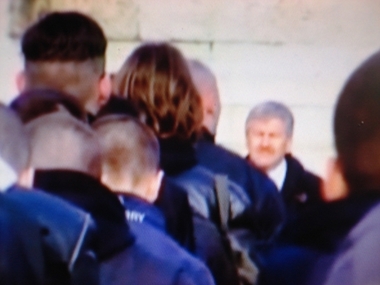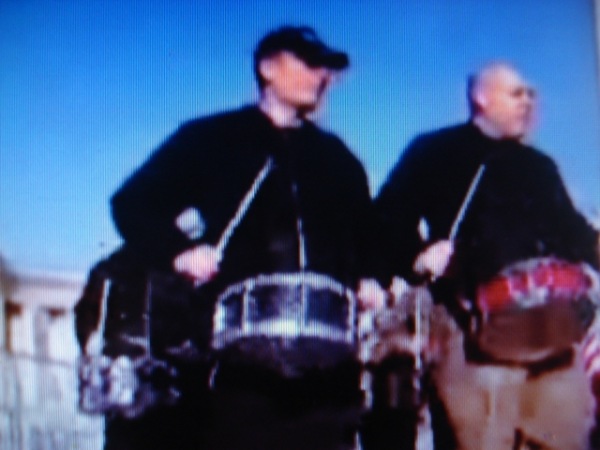Paprika, salami, Tokai wine, Gypsy music, colourful folklore and tourist boats on the Danube – what other clichés do you associate with Hungary? How about men in black uniforms and black boots waving fascist-type flags, hurling petrol bombs and chanting racist and anti-Semitic slogans? But doesn’t that sound more like a throwback to the dark days of the last century than a picture of a modern EU country?
After more than a year of political turmoil, street riots and neo-fascist attacks are becoming part of life in Hungary today. The country’s struggle for democracy is being threatened by the growth of extreme right-wing forces peddling the old drastic remedies of racism, neo-fascism and anti-Semitism as cures for social insecurity. But meanwhile, Hungary’s Jews and other minorities are examining their past and claiming their place in the present.
In the first of two articles, Karen Margolis charts the recent rise of neo-fascism in Hungary. The second article will describe how some Hungarians are confronting aspects of their history, and building for the future with new institutions and the gradual revival of Jewish life in the capital, Budapest.
The Black Guards of Budapest
In autumn 2006, rioters took to the streets in Budapest, burning cars, attacking buildings and ransacking the state TV station. They were protesting because the prime minister of the Socialist-led government had been caught lying to voters about economic reforms to win the election campaign. Not a new story in politics, but it was a shock for Hungary, which prided itself on its peaceful transition from Communist rule to democracy in the early 1990s. The violence reminded some older Hungarians of events 50 years before, when Hungary became the first country to stage a democratic uprising against Soviet domination. Images of tanks on the streets and the brutal repression that followed still haunt the nation today.
The riots of 2006 launched a wave of unrest that has much deeper roots than political malpractice. For over a year now, the area around Budapest’s magnificent neo-Gothic Parliament building on the Pest bank of the Danube has been the scene of regular demonstrations with slogans that use history to justify retrograde demands. One day, Andras Kovacs, a history professor at the nearby Central European University, decided to do some research on the spot. “I went up to a group of demonstrators and asked what they were protesting about,” he told me. “They said they wanted to return to the days of Greater Hungary.” Kovacs, who heads research projects on nationalism and minorities, explained to me that the demonstrators meant the pre-First World War situation, before the Treaty of Trianon deprived Hungary of 72% of its former territories. “If you want Greater Hungary back,” he replied to the demonstrators, “that means you want Croatia to be part of Hungary again.”
“No, no,” they protested vehemently. “We hate the Croatians! We don’t want anything to do with them!”
What they actually want is a return to the situation in the years between the two world wars when Miklos Horthy, the “Regent of Hungary” ruled over the first fascist dictatorship in Europe. Horthy defeated Hungary’s Communist government in 1920, brutally suppressed all opposition and remained in power until 1944. One of his key political goals was a Greater Hungary based on the Hungarian Kingdom of the Middle Ages. In return for deals in the 1930s and ’40s with fascist Italy and Nazi Germany that gave Hungary territories in Slovakia and Romania, Hungary fought on the Axis side in the Second World War. When Hitler’s armies invaded Hungary in 1944, Horthy set up a collaborationist government to avoid German takeover.
By the spring of 1945, the war had claimed the lives of millions of Hungarians, and much of Budapest was reduced to ruins. Hungary’s Jewish community, once one of the most flourishing in central Europe, numbered 825,000 people in the pre-war years. 550,000 were murdered by the Nazis (many in extermination camps), as well as thousands of members of the Sinti and Roma population and other cultural and ethnic minorities. One of the most moving Holocaust memorials I have ever seen stands on the bank of the Danube in Pest. It marks the site where, on the night of 8 January 1945, Arrow Cross militiamen forced hundreds of Budapest’s Jews – men, women and children – to strip themselves naked, and then shot them from behind so that they fell face forward into the river. The memorial is a sculpture of scattered empty shoes lying as if their owners had just left them there.
The terrible wartime slaughter by the occupying Nazis and Hungarian fascists was immediately followed by the Stalinist repression imposed by Hungary’s post-war Communist regime, which firmly kept the lid on the minority problems endemic to the region. The human cost of war, shifting borders, expulsion, ethnic cleansing and refugee movements dominated 20th-century life in Hungary, as in surrounding Soviet-bloc countries like Yugoslavia, Czechoslovakia and Romania.
The extreme right wing in Hungary today not only has this legacy to nourish it, but also the current problems of rising prices, a rapacious kind of capitalism, the growing gap between rich and poor, an outdated infrastructure that urgently needs modernising, and mounting pressure from the European Union to get in line socially and economically with the rest of Europe. Faced with all this, Hungary’s increasingly aggressive right wing has used the anti-government turmoil since 2006 to attack liberalism in general and minorities in particular. Mob violence regularly dominated the headlines in Hungary all through 2007. Here are a few key entries from the calendar:
* On 7 July 2007, hundreds of skinheads and neo-Nazis attacked a Gay Pride march in Budapest, throwing eggs, bottles, smoke bombs, Molotov cocktails and plastic bags of sand at the 2,000 marchers. The attackers were mainly from two right wing groups, the Movement for a Better Hungary and the Hungarian National Front. According to a report in the San Francisco Bay Times (26 July 2007), they shouted, “Faggots into the Danube, followed by the Jews”, “soap factory”, and “filthy faggots”. Gay pride supporters were attacked later on their way to the post-demonstration party at an open-air nightclub on the Danube.
Hungary’s right wing is angered by the support for homosexuality in high places. One of the anti-gay protestors’ main targets was Gábor Szetey, the government’s secretary of state for human resources, who publicly came out as gay just before the Gay Pride demonstration when he opened Budapest’s 12th Lesbian, Gay, Bisexual and Transgender Festival of culture and arts on 5 July.
Budapest’s mayor, Gábor Demszky, is a staunch liberal who played a key role in the anti-Soviet opposition in Hungary long before the transition to democracy. He was quick to denounce the anti-gay attacks with a clear message. “Physical violence and murderous threats were used against peaceful marchers expressing their sexual identities,” he said. “No genuine democrat can remain silent about this! It was intolerant, primitive and cowardly…” Demszky went on to praise the courage of the marchers, whose main demand was the right for gay couples to marry.
“As mayor of Budapest it is my duty to stand up for all those who are persecuted in Budapest,” he added. “If need be, you can also count me as Jewish, Gypsy and gay. ... We won’t let anyone live in fear because they belong to a minority.”
Fine words. Demszky, along with other leading politicians, is anxious to stress that the extreme right-wingers are only a minority. The Budapest police have been equipped with modern riot control weapons to try and stop the turmoil on the streets, but that hasn’t deterred the demonstrators. While the men in power rush to condemn the neo-fascists, nobody seems capable of stopping them hitting the headlines and getting plenty of publicity for their ideas. Only a month after the Gay Pride march, the extremist bully boys were back on the streets again.
* In August 2007, neo-fascist groups desecrated the Soviet Military Memorial in Budapest, which commemorates the Red Army soldiers and anti-fascists killed in the Second World War. On 14 August 2007 a declaration by two anti-fascist groups on the website of Attac Hungary condemned the desecration and accused the government of cowardice and short-sightedness in not dealing with the “everyday neo-fascist provocations” in Hungary. “The Hungarian Parliament is unable to create a clear-cut legal basis for the Police to put an end to the neo-fascist disturbances,” the declaration said. These anti-fascist groups may have their own brand of nostalgia for the ‘good old days’ of Soviet brotherhood, but they play an essential watchdog role. In the same statement they pointed out the dangers of a new force on the neo-fascist political scene – the Hungarian Guard.
* On Saturday 25 August the Magyar Gárda (Hungarian Guard) swore in its first members at Buda Castle, the historic seat of Hungarian kings. The old fortress, which stands high on a hill above the city, commands a breathtaking panorama of the Danube with its glittering bridges. It is surrounded by stately palaces now used as art galleries, museums and government offices. In these symbolic surroundings, the very stuff of picture postcards, around 56 Gárda members wearing black uniforms and caps played out a solemn enrolment ritual under the protection of police who formed a barrier against the counter-demonstration by the Anti-Fascist League.
The Guard was set up by a small extreme-right wing party, Jobbik, which has failed to gain any seats in Parliament and is resorting to spectacular shows and violent tactics, much like its fascist forebears in the 1930s, to win support and influence. Survivors of the Holocaust, and Mazsihisz, the Federation of Hungarian Jewish Communities, who had already been warning that anti-Semitism was on the rise, sounded the alarm immediately. The Guard’s chosen coat of arms is a variation on the red-and-white Arpad stripes, a medieval flag associated with the Nazi-aligned Arrow Cross party that briefly held power in Hungary during the Second World War. The Arrow Cross was directly responsible for much of the butchery of Hungary’s Jews.
The Hungarian Guard website announced that it was formed because “Hungary lacks physical, mental and spiritual self-defence”. The Guard’s charter says, “Conscripts will carry out physical, mental and spiritual training to help maintain public order, preserve Hungarian culture and defend the nation in extraordinary situations.”
This sounds like a quote lifted directly from a manual of the SA, SS or any other of Hitler’s paramilitary gangs, who also prided themselves on being guards of honour and guardians of national security. In October 2007 the Guard claimed to have enrolled 600 new members – just in time for the next round of riots and demonstrations.
* On 23 October 2007, thousands of protestors took to the streets of Budapest on the national holiday on the anniversary of the 1956 uprising against Soviet domination. Several hundred nationalists, their faces covered with scarves, waved flags as they set off petrol bombs and firecrackers. The day after, the city was strewn with gutted cars, broken glass and empty tear-gas canisters fired by police in riot gear who failed to control the violence.
The rioters had again demanded prime minister’s Gyurcsány’s resignation. With Jewish groups and liberals accusing the Hungarian Guard of fomenting anti-Semitic and anti-Roma feeling, Gyurcsány came under pressure to take a stand. “When a group that denies the rights of others, and sometimes takes active measures to promote prejudice and fear, decides to set up a paramilitary organisation, we need to pay special attention,” he said. That was hardly the tough response which anti-fascists had been demanding.
Gabor Vona, the leader of the nationalist Jobbik party and founder of the Hungarian Guard, obviously feels encouraged by the weak response to his blatant provocation, and enjoys being limelighted by the media. In a press interview after the memorial day riots he threatened further violence. The prime minister’s admission of lying had “set things alight,” he said. “It could happen again if there was a spark.”
According to the Hungarian Times, Mr Vona denied that the Guard was anti-foreigner, but said, “Hungary should above all be a good place for Hungarians, and they should have priority here.” Jobbik and the Guard have been characterised as anti-Semitic, yet many observers see Roma as their main target. Roma constitute around one-tenth of the population of northern Hungary, and have been victims of discrimination under every regime for centuries.
Around 600,000 Roma live in Hungary, making it the fourth largest Roma population in Europe after Romania, Spain and Bulgaria. At a United Nations press conference on 29 January 2007 for an exhibition on the Holocaust murder of Roma and Sinti, Romani Rose, Chairman of the Central Council of German Sinti and Roma, said the term “Holocaust” meant not only the murder of the 6 million Jews, but also the systematic genocide of 500,000 Roma and Sinti in Nazi-occupied Europe. In spite of that historical experience, some 12 million Roma and Sinti — Europe’s largest minority — are still subject to discrimination, social disadvantage and open violence in their everyday lives.
The degrading living conditions of millions of Roma and Sinti are reminiscent of South Africa’s former apartheid system, Rose added. Living in ghetto-like housing conditions, millions of the Roma and Sinti are often cut off from any infrastructure, especially in Eastern European countries. Infant mortality is extremely high. Frequently the victims of pogroms, racially motivated murder and other acts of violence — often by state security forces — Roma and Sinti have suffered marginalization and racism. In Hungary, even under communism, democratic opposition members persistently tried to draw attention to this racist discrimination and the appalling conditions in which some Sinti and Roma communities lived.
And now the Sinti and Roma have the Hungarian Guard to add to their troubles. “In Hungary, everyone who wants order is labelled a racist,” Hungarian Guard supporter Istvan Szemecs told a Reuters news agency reporter. He went on to repeat the stereotyped prejudices of old: “They (Roma) live with filth and dirt and if anybody wants to do away with this then they are labelled a racist.”
People like Szemecs prove how wrong it is to talk about our EU neighbours in central Eastern Europe as the “new” Europe. There are forces in all these countries trying to revive the research is particularly interesting because he distinguishes clearly between diehard anti-Semites and people who rely on stereotypes, and looks at the social pressure that leads to latent anti-Semitism, where people are reluctant to voice their views because of general disapproval, but cling to them all the same. This group included significantly more people who originate from or live in Budapest, and relatively highly educated people. Kovacs also identified latent anti-Semitism among what he calls “left-wing frustrated” respondents who expressed personal frustration, distrust of politics and democratic state institutions, social distress, loss of norms and “nostalgia for the communist past”. This sounds all too familiar to observers of growing right-wing extremism in eastern Germany. Here again in Hungary, the Jews are a convenient scapegoat for people with bundles of problems they feel powerless to solve.
Beyond the headlines and statistics, what does this mean for daily life in Budapest? I caught a glimpse when I was there in spring 2007 and a Jewish friend who works at the Holocaust Museum invited me and my family to celebrate the Sabbath on a Friday evening. When we entered the front hall of the old apartment house in Buda where she lives, she pointed wordlessly to a Star of David scratched aggressively into the paintwork on the wall next to the letterboxes. As we climbed the stairs, she whispered that she didn’t know whether the culprit was a neighbour or a stranger.
Upstairs, the lines of battle were laid out. At the door of her flat was a brightly-coloured decorative ceramic nameplate of the type you find in Israeli tourist shops, and a mezuzah, the holy charm Jews traditionally affix to their doorposts. “After we put up the nameplate, our neighbour hit back,” she said. Looking towards the opposite doorway, she indicated a large poster map spread over the wall between the two apartments with a big banner title. “What does it say?” I asked.
“Greater Hungary,” she replied.
© Karen Margolis for mut-gegen-rechte-gewalt 2008 / NDR-photos showing the german neonazi-leader Voigt at a youth meeting in Budapest
Another news-reportage from Hungary please read in german: http://www.dradio.de/dlf/sendungen/europaheute/731848/ 

